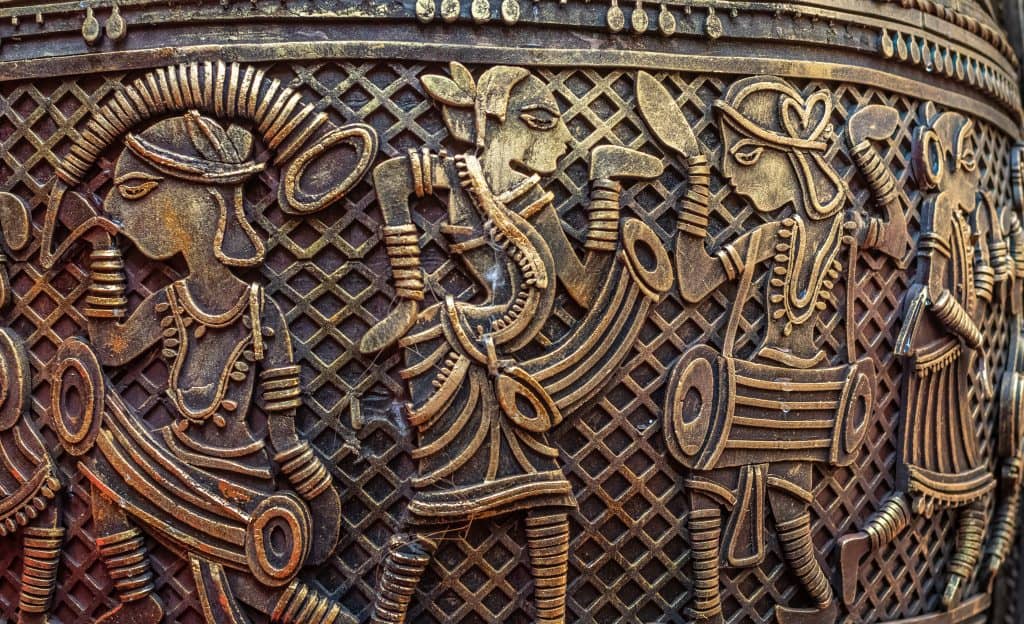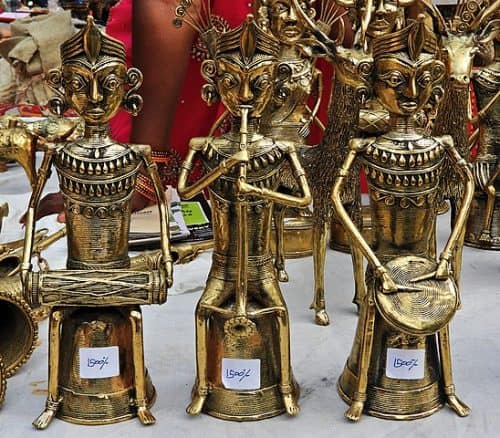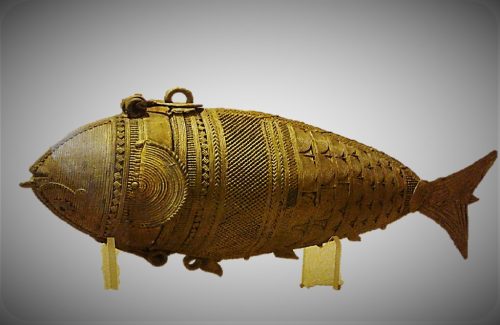Explore the enchanting world of Dhokra Art, where ancient techniques meet unique designs and eco-friendly materials.

Dhokra Art: A Living Legacy from the Bronze Age to Modern Odisha
The Bronze Age in India, beginning around 3300 BC with the rise of the Indus Valley Civilization, introduced remarkable advancements in metallurgy that remain unparalleled today. The process of casting non-ferrous metals using the lost-wax casting method is known as dhokra (sometimes spelt Dokra). Casting metal objects using this method has been done in India for almost 4,000 years, and it is being done today.
The Dancing Lady of Mohenjo-Daro is recognised as one of the oldest known examples of an artefact made of lost wax. Because of their austere appearance, endearing folk themes, and straightforward simplicity, the wares produced by Dhokra craftsmen are very popular not just in India but also in international markets.
Dhokra objects such as horses, elephants, peacocks, owls, religious pictures, measuring bowls, and lamp caskets, amongst other things, are very highly valued. Using the lost wax method, copper-based alloys have been cast in several places, including China, Egypt, Malaysia, Nigeria, and Central America.
Named after the nomadic Dhokra Damar tribe from West Bengal and Odisha, Dhokra art has deep roots in these regions. Where is Dhokra art from is a popular question. Odisha, in particular, has been a central hub for this traditional craft. While traces of Dhokra art can be found across the Indian subcontinent, Odisha’s interior and rural areas became the primary centres where artisans honed their skills, creating unique and timeless pieces.
The Unique Charm of Odisha’s Dhokra
Dhokra art is inherently unique, with no two pieces ever exactly alike. Odisha’s Dhokra stands out for its distinctive darker hue, attributed to the specific soil and wax used in the region. Known as ‘Black Metal Dhokra,’ these pieces from Kandhamal and Dhenkanal may also exhibit a bluish tint. The smooth curves and clean lines of Odisha’s Dhokra further distinguish it from those produced elsewhere in India.
Initially, Dhokra handcrafted items were produced in several districts of Odisha, including Puri, Khurda, Mayurbhanj, Dhenkanal, and others. Over time, Dhenkanal emerged as the primary epicentre for Dhokra art, preserving the craft even as its popularity waned in other regions.
In Dhenkanal, the villages of Sadeibareni and Navjeevanpur stand out for their Dhokra artistry. The Ghantara tribes in these villages are dedicated to various stages of the Dhokra crafting process, from mould-making to wax softening and thread wrapping.
Visiting the Dhokra artisans in Odisha offers a rare glimpse into the ancient world of the Bronze Age. The traditional methods, largely unchanged over millennia, involve meticulous handwork, making each piece labour-intensive and time-consuming. Despite the pressures of modernization, the Ghantara artisans remain steadfast in preserving the authenticity and beauty of their craft, even as they adapt to contemporary tastes.
Each piece reflects the tribal lifestyle, with designs inspired by traditional attire and natural motifs such as the sun, moon, branches, leaves, and flowers. The laborious process, which can take months, imbues each creation with a unique beauty and a touch of the artisans‘ daily hardships.
Exploring the secluded villages of Odisha, such as Sadeibareni, about 65 km from Bhubaneswar, and the more remote Navjeevanpur, allows one to witness firsthand the enduring legacy of Dhokra art. Here, the past and present blend seamlessly, creating a timeless testament to the region’s rich cultural heritage.
History of Dhokra Art
The nomadic Indian tribe known as the Dhokar Damar, which is native to the eastern region of the nation, is where the art form that bears their name got its strange and appealing moniker. The Bankura-Dariapur tract in West Bengal, as well as some regions in Madhya Pradesh and Odisha, were the original homes of this tribe.
Historians think that the groups of tribal people who live in this area and are responsible for the Dhokra art that is so well-known in West Bengal are the primary keepers of this heritage. It is interesting to note that this highly valued form of Indian art is not confined to a single area of the nation.

It is thought that the craftsmen could have gone from one section to another and brought with them the experience and abilities of Dhokra, passing it on from one family to the next as they went. The outcome of this is that the tribal community that was mainly involved in making Dhokra art and lived in the region encompassing Birbhum, Purulia, Burdwan, and Midnapore has now spread to the neighbouring regions as well, having evolved this heritage to include regionalized and interpretations of the art they created.
Today, members of this tribe may be found living in all of the states that make up India’s eastern belt, from Jharkhand to Chattisgarh to Telangana to West Bengal and Odisha. There is reason to believe that some of India’s oldest tribes, such as the Gonds of Madhya Pradesh and the Bhils of Rajasthan, Western Maharashtra, Western Madhya Pradesh, and southeastern Gujarat, have been practising this folk art for many years.
These regions include Rajasthan, western Maharashtra, western Madhya Pradesh, and southeastern Gujarat. As a consequence of this, the art form is also often known as the Dhokra art of Jharkhand and the Dhokra art of Chattisgarh. In addition, the area of Bastar in Chattisgarh is well-known for the significant contribution it has made to this art form.
The Bastar Dhokra Art has earned a reputation and a place of prominence not only in the domestic market but also in the global market.
The local weekly marketplaces in the area were the only places in the past where one could purchase the ethnic designs that are used in this art.
Process of casting Dokra
Casting in solid wax and casting in hollow wax are the two primary procedures involved in lost wax casting. The former is more widespread in the southern part of India, whilst the latter is more prevalent in the central and eastern parts of the country. Hollow casting is by far the more conventional approach, and it utilises the clay core.
Solid casting, on the other hand, employs a large piece of wax to produce the mould, as opposed to hollow casting, which uses clay. The first thing that has to be done to create a hollow cast using the lost wax method is to construct a clay core that approximately corresponds to the form of the finished cast.

After that, a coating of wax made of pure beeswax, resin from the plant Damara Orientalis, and nut oil is applied on top of the clay core. After that, the wax is moulded and carved into its final form, complete with all of its intricately designed and decorated elements.
It is then coated with compacted clay, which takes the negative shape of the wax on the inside and transforms it into a mould for the metal that will be placed within it. This process is called “lost wax casting.” When the clay is heated, drain tubes are left for the wax, which disappears as it melts away. After that, the wax is removed and replaced with molten metal, which often makes use of brass scrap as the primary raw material.
The molten metal that is put in solidifies somewhere between the centre and the inner surface of the mould as it travels through the mould. The metal is poured into the mould, and it solidifies into the same form as the wax. After that, the outermost layer of clay is chipped away, and the symbol made of metal is polished and completed to the required degree.
Symbolism of Dhokra Art
You just need to take one glance at the relics to start feeling sentimental about the prehistoric age, back when hunting was the primary occupation of people. Miniatures of men, women, and children, as well as Hindu deities and goddesses, are typical subjects in Dhokra art. Other popular subjects include animals.
The diversity of creatures, from equines to elephants, tortoises to owls, and everything in between, is another recurring motif. In Hindu mythology, each of these animals is associated with a certain concept or has some kind of importance. For instance, the owl is associated with wealth and death, but the elephant is associated with sage advice. Both the horse and the tortoise are symbolic of motion, yet the tortoise is more often associated with the feminine gender.

All of these animals are profoundly ingrained in the Hindu faith, and each one has played an important symbolic role in the development of the religion throughout time. Craftspeople have, throughout time, experimented with teaching different types of art based on their day-to-day lives to produce dhokra wall art. The spectrum of Dhokra art form now includes things like sacred lamps, urns, bowls, and other utensils and implements.
Where to buy
The Bastar area of Chhattisgarh is where the Dhokra art style originated. This kind of art is also practised by indigenous people in the Indian states of Madhya Pradesh, Odisha, and West Bengal. It may be purchased at Indian Crafts House, in addition to shopping areas in the city such as Greater Kailash and Malviya Nagar in Delhi.
Dhokra Art is a remarkable blend of ancient techniques, unique designs, and eco-friendly materials. Its rich history and cultural significance make it highly valued both in India and globally. The intricate process and symbolic motifs of Dhokra pieces reflect the timeless beauty and creativity of this traditional Indian craft, celebrating the artisans’ skill and heritage.
Read more: Latest



